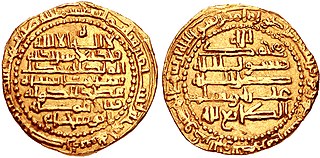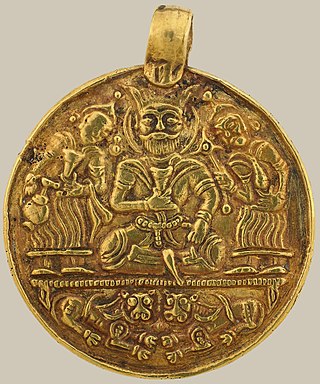
The Buyid dynasty or Buyid Empire was a Zaydi and later Twelver Shi'a dynasty of Daylamite origin. Founded by Imad al-Dawla, they mainly ruled over central and southern Iran and Iraq from 934 to 1062. Coupled with the rise of other Iranian dynasties in the region, the approximate century of Buyid rule represents the period in Iranian history sometimes called the Iranian Intermezzo.

Abū ʾl-Qāsim al-Faḍl ibn al-Muqtadir, better known by his regnal name of al-Mutīʿ li-ʾllāh, was the Abbasid caliph in Baghdad from 946 to 974, ruling under the tutelage of the Buyid emirs.

Abu Bakr ʿAbd al-Karīm ibn al-Faḍl, better known by his regnal name al-Ṭāʾiʿ liʾllāh/biʾllāh, was the Abbasid caliph of Baghdad from 974 to his deposition in 991. He was in office during the domination of Iraq by the Shi'a Buyid dynasty, and as a result is generally considered a powerless figurehead under the thumb of the Buyid emirs. His tenure was also marked by strife between rival Buyid rulers and the frequent change of hands of Baghdad: al-Ta'i' himself was raised to the throne by a rebel Turkic general, Sabuktakin, who deposed al-Ta'i's father, al-Muti'. During periods of such strife, al-Ta'i' was able to exert some measure of political independence, but under stronger rulers he was sidelined, and was obliged to marry the daughters of the emirs Izz al-Dawla and Adud al-Dawla. Al-Ta'i's status suffered under Adud al-Dawla in particular, who turned to pre-Islamic Persian models for legitimacy, and relegated Iraq to the status of a simple province ruled from Fars. Al-Ta'i' was deposed on 22 November 991 by Baha al-Dawla, and replaced with his cousin, al-Qadir. He spent the rest of his days, until his death in 1003, confined to the caliphal palace.
Ibn Miskuyah, full name Abū ʿAlī Aḥmad ibn Muḥammad ibn Yaʿqūb Miskawayh al-Rāzī was a Persian chancery official of the Buyid era, and philosopher and historian from Parandak, Iran. As a Neoplatonist, his influence on Islamic philosophy is primarily in the area of ethics. He was the author of the first major Islamic work on philosophical ethics entitled the Refinement of Character, focusing on practical ethics, conduct, and the refinement of character. He separated personal ethics from the public realm, and contrasted the liberating nature of reason with the deception and temptation of nature. Miskawayh was a prominent figure in the intellectual and cultural life of his time.

Abu Nasr Firuz Kharshadh, better known by his laqab of Baha al-Dawla was the Buyid amir of Iraq (988–1012), along with Fars and Kerman (998–1012). His early reign was dominated by struggles with his rival relatives over control of the western Persian provinces, but by 998 he managed to establish his supremacy over the Buyid confederation. His reign nevertheless saw the increasing encroachment of neighbouring powers on Buyid territory, and marks the beginning of the decline of the Buyids' power. He was the third son of 'Adud al-Dawla.

Abu Kalijar Marzuban, also known as Samsam al-Dawla was the Buyid amir of Iraq (983–987), as well as Fars and Kerman. He was the second son of 'Adud al-Dawla. The Abbasids recognized his succession and conferred upon him the title Samsam al-Dawla. He lacked the qualities of his father 'Adud al-Dawla and failed to have a grip upon his state affairs. His rule was marked by revolts and civil wars.

Bakhtiyar, better known by his laqab of Izz al-Dawla, was the Buyid amir of Iraq (967–978).

Ahmad ibn Buya, after 945 better known by his laqab of Mu'izz al-Dawla, was the first of the Buyid emirs of Iraq, ruling from 945 until his death.
Abu'l-Hasan Ali ibn al-Hasan, better known by his laqab of Fakhr al-Dawla was the Buyid amir of Jibal, Hamadan (984–997) and Gurgan and Tabaristan (984–997). He was the second son of Rukn al-Dawla.

Hasan, better known by his laqab as Rukn al-Dawla, was the first Buyid amir of northern and central Iran. He was the son of Buya.

Abu Mansur Buya, better known by his honorific title of Mu'ayyad al-Dawla was the Buyid amir of Hamadan (976–983), Jibal (977–983), Tabaristan (980–983), and Gorgan (981–983). He was the third son of Rukn al-Dawla.
'Imran ibn Shahin was a Nabataean and the founder of a state in the Batihah marshlands in the 10th century. His reign was marked by decades of struggle against the Buyids of Iraq.

Fannā (Panāh) Khusraw, better known by his laqab of ʿAḍud al-Dawla was an emir of the Buyid dynasty, ruling from 949 to 983, and at his height of power ruling an empire stretching from Makran to Yemen and the shores of the Mediterranean Sea. He is widely regarded as the greatest monarch of the dynasty, and by the end of his reign he was the most powerful ruler in the Middle East.
Abu 'l-Fadl Muhammad ibn Abi Abdallah al-Husayn ibn Muhammad al-Katib, commonly known after his father as Ibn al-'Amid was a Persian statesman who served as the vizier of the Buyid ruler Rukn al-Dawla for thirty years, from 940 until his death in 970. His son, Abu'l-Fath Ali ibn Muhammad, also called Ibn al-'Amid, succeeded him in his office.
Abu Muhammad al-Hasan al-Muhallabi was an Arab statesman who served as the vizier of the Buyid amir Mu'izz al-Dawla. He was from the prominent Muhallabi family.
Hasanwayh, Hasanwayh Al-kurdi also known as Abu'l-Fawaris, was the Kurdish ruler and founder of the Hasanwayhid dynasty, ruling from 961 to 979.
Abu'l-Faraj Muhammad, was an Iranian statesman Fasanjas family who served the Buyid dynasty.
Bahram ibn Ardashir al-Majusi was a Buyid officer of Zoroastrian extraction who during his early career served the Buyid ruler Adud al-Dawla, and then later the latter's son Samsam al-Dawla.
Alptakin was a Turkish military officer of the Buyids, who participated, and eventually came to lead, an unsuccessful rebellion against them in Iraq from 973 to 975. Fleeing west with 300 followers, he exploited the power vacuum in Syria to capture several cities, including Damascus. For the next three years, Alptakin withstood attempts by the Fatimid Caliphate to capture Damascus, until he was defeated and captured by Caliph al-Aziz Billah. Taken to Egypt and incorporated into the Fatimid army, he was poisoned by the vizier Ibn Killis shortly after this.
Abu Ishaq Ibrahim, also known by his honorific title of Umdat al-Dawla, was a Buyid prince, who was the youngest son of the Buyid ruler Mu'izz al-Dawla.